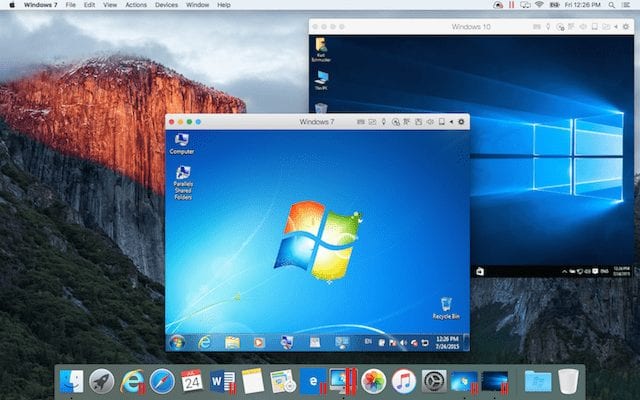

- #Macbook parallels vs vmware mac os
- #Macbook parallels vs vmware install
- #Macbook parallels vs vmware mac
- #Macbook parallels vs vmware windows
#Macbook parallels vs vmware mac
It also doesn’t seem to bring the rest of the Mac to a grinding halt as Parallels can do sometimes.
#Macbook parallels vs vmware windows
Switching between a Mac app and a Windows app within Fusion seems snappier.

In daily use, with a couple of Windows (2000 and XP) VMs running simultaneously, I find that Fusion feels slightly more responsive than Parallels. No doubt the situation changes monthly as both companies bring out new point releases. In addition, Fusion has multi-core support which can speed things up considerably. I believe the general consensus is that Parallels is a bit faster for XP, and Fusion is a bit faster for Vista. Performance-wise, I couldn’t really tell much of a difference between Parallels and Fusion. However, installation of the tools is a pain compared to Parallels’ tools, requiring much command-line fiddling and compiling. It just worked.Īs with Parallels, VMware comes with tools for Linux (as well as Windows, of course), allowing you to do things like move the mouse between the VM and the Mac desktop, and changing the VM screen size just by resizing the window. Installation on VMware was flawless – no problems with X, no messing about with config files.
#Macbook parallels vs vmware install
This was the exact same Ubuntu I previously tried to install on a Parallels Desktop VM, with minimal success. I had a go at installing Ubuntu Linux 7.10 on a new VMware VM. Parallels fades the brightness up and down Fusion, not to be outdone, fades the colours in and out, Bagpuss-style. Both apps also seem obsessed with providing smooth fading in and out when you resume or suspend the OS. Suspend and resumeīoth apps let you suspend the guest operating system, which is great as you can save your current Windows session with all apps open, close down Parallels/Fusion, and carry on exactly where you left off later. However, I find that SmartSelect can result in a very cluttered “Open With” menu in the Finder, so it’s not all roses. This feature can be quite useful, and there’s no equivalent in the current version of Fusion. doc file in the Finder, it opens in Windows. doc file on the Mac with Word on the Windows guest OS, so that when you double-click a. Parallels has a feature called SmartSelect that lets you associate file types on one OS with applications on the other. Combine this with the “hide the Windows desktop” mode (known as Coherence in Parallels and Unity in VMware), and you hardly even know you’re running Windows. You can even right-click an icon and choose Keep in Dock you can then launch the Windows app just by clicking the icon, even if Parallels/VMware isn’t running at the time. In contrast, Parallels’ Applications menu only allows you to choose from recently-run apps, or display the Start menu – not as slick.īoth Parallels and VMware show running Windows apps as Dock icons, as if they were Mac apps. This basically mirrors the Windows Start menu, making it easy to launch Windows apps without having to deal with the Start menu: One nice feature of VMware is its Applications menu. I’m pleased to say that Fusion’s UI is a breath of fresh air in comparison, and behaves more like I’d expect a Mac app to behave.

I have to say, I’m not a big fan of the Parallels user interface it always seems odd how it opens new instances of itself for new VMs, and some of the dialogs seem like they were written by someone with English as their second language. Once I’d successfully converted my Parallels VM to a Fusion VM, I fired up Fusion. The Importer was a bit ropey – it spent 15 minutes converting the drive before informing me that the VM was suspended, so it couldn’t finish the import – but to be fair, it’s still in beta.

I didn’t want to muck about installing a fresh copy of Windows, or deal with Windows XP reactivation grief, so I used the VMware Importer to migrate a Windows 2000 Parallels virtual machine across to VMware Fusion. The versions I’m reviewing here are Parallels Desktop 3.0 (Build 5582) and VMware Fusion 1.1.2 (87978). So I thought I’d give Fusion a quick spin and see how it compares. It does the job well enough, but recently the nice folks at VMware gave me a review copy of VMware Fusion. I’ve been using Parallels Desktop since I bought my Mac back in 2006 (in fact I bought Parallels before the Mac!).
#Macbook parallels vs vmware mac os
There are two applications that you can use to run Windows simultaneously with Mac OS X: Parallels Desktop and VMware Fusion. By running Windows on your Mac as well as Mac OS X, you get the best of both worlds – the loveliness of MAC OS X, and the compatibility of Windows. Why would you want to run Windows on a Mac? Well, there are many applications – including most games – that are only available for Windows. One of the great things about Intel Macs is that you can run Windows on them.


 0 kommentar(er)
0 kommentar(er)
